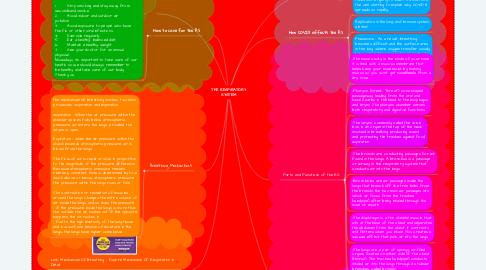THE RESPIRATORY SYSTEM
by Juan Sia

1. 7 Ways to Improve Respiratory Health
2. Link: Mechanism Of Breathing - Explore Mechanism Of Respiration In Detail
3. Breathing Mechanisms
3.1. the mechanism of breathing involves two main processes: inspiration and expiration. Inspiration - When the air pressure within the alveolar spaces falls below atmospheric pressure, air enters the lungs, provided the larynx is open. Expiration - when the air pressure within the alveoli exceeds atmospheric pressure, air is blown from the lungs. The flow of air is rapid or slow in proportion to the magnitude of the pressure difference. Because atmospheric pressure remains relatively constant, flow is determined by how much above or below atmospheric pressure the pressure within the lungs rises or falls. The contraction or relaxation of muscles around the lungs changes the entire volume of air inside the lungs, and so does the pressure. - If the pressure inside the lungs is more than the outside, the air rushes out. If the opposite happens, the air rushes in. - Due to the high elasticity of the lung tissue and low surface tension of moisture in the lungs, the lungs have higher compliance.
4. How to care for the RS
4.1. There are several ways of taking care of our respiratory system. Here are some ways in which we could take care ours 1. Stop smoking and stay away from secondhand smoke. 2. Avoid indoor and outdoor air pollution. 3. Avoid exposure to people who have the flu or other viral infections. 4. Exercise regularly. 5. Eat a healthy, balanced diet. 6. Maintain a healthy weight. 7. See your doctor for an annual physical. Nowadays, its important to take care of our health, so we should always remember to be healthy and take care of our body. Thank you.
5. Link: What are the effects of COVID-19 on the lungs?
6. Link: Respiratory System: Functions, Facts, Organs & Anatomy
7. How COVID affects the RS
7.1. Cell invasion and viral replication in the nose - As a result, COVID19 can bind 10 times more tightly to insert its RNA into the cell, starting to explain why COVID-19 spreads so rapidly.
7.2. Replication in the lung and immune system alerted
7.3. Pneumonia - As a result, breathing becomes difficult, and the surface area in the lung where oxygen transfer usually takes place becomes reduced, leading to breathlessness.
7.4. Acute respiratory distress syndrome, the cytokine storm, and multiple organ failure
8. Parts and Functions of the RS
8.1. -The nasal cavity is the inside of your nose. It is lined with a mucous membrane that helps keep your nose moist by making mucus so you won't get nosebleeds from a dry nose.
8.2. -Pharynx, (Greek: “throat”) cone-shaped passageway leading from the oral and nasal cavities in the head to the esophagus and larynx. The pharynx chamber serves both respiratory and digestive functions.
8.3. -The larynx, commonly called the voice box, is an organ in the top of the neck involved in breathing, producing sound and protecting the trachea against food aspiration.
8.4. -The bronchi are conducting passages for air found in the lungs. A bronchus is a passage or airway in the respiratory system that conducts air into the lungs.
8.5. -Bronchioles are air passages inside the lungs that branch off like tree limbs from the bronchi—the two main air passages into which air flows from the trachea (windpipe) after being inhaled through the nose or mouth.
8.6. -The diaphragm is a thin skeletal muscle that sits at the base of the chest and separates the abdomen from the chest. It contracts and flattens when you inhale. This creates a vacuum effect that pulls air into the lungs.
8.7. -The lungs are a pair of spongy, air-filled organs located on either side of the chest (thorax). The trachea (windpipe) conducts inhaled air into the lungs through its tubular branches, called bronchi.
8.8. -The trachea, commonly known as the windpipe, is a tube about 4 inches long and less than an inch in diameter in most people.


